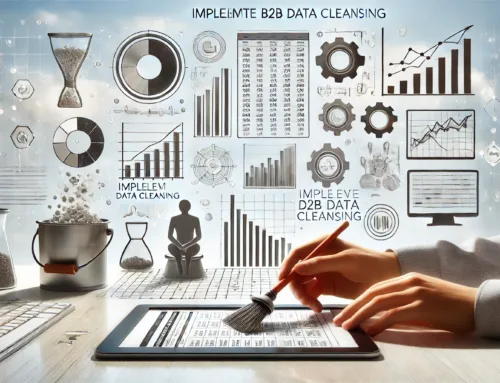To streamline B2B data cleansing, you may find yourself overwhelmed by the sheer volume of data that needs attention. However, by strategically focusing on key areas for improvement and implementing targeted solutions, you can significantly enhance the efficiency and accuracy of your data processes. Ready to discover practical tips and techniques that can revolutionize your B2B data cleansing practices?
Identify Process Bottlenecks
When streamlining B2B data cleansing, the initial step is to identify process bottlenecks that hinder efficiency and accuracy. Data analysis plays a crucial role in this phase, allowing you to pinpoint areas where data quality and workflow optimization are lacking. By conducting a thorough data analysis, you can uncover inconsistencies, duplicates, and errors that impede the cleansing process. This insight enables you to prioritize the most critical issues, ensuring a more targeted and effective approach to data cleansing.
Workflow optimization is another key aspect of identifying process bottlenecks. By analyzing the current workflow, you can identify redundant tasks, unnecessary steps, or areas where automation could significantly improve efficiency. Streamlining the workflow not only accelerates the data cleansing process but also reduces the likelihood of errors or oversights.
Prioritize Data Quality
To successfully streamline B2B data cleansing, it is imperative to prioritize data quality. Data accuracy plays a pivotal role in ensuring the reliability and effectiveness of your business operations. By focusing on maintaining high levels of data accuracy, you can minimize errors that may arise from incomplete or outdated information. Implementing robust data validation processes is essential to verify the integrity and consistency of your data. Utilizing automated validation tools can help identify discrepancies and discrepancies, allowing you to rectify them promptly.
Data validation ensures that the information you rely on for decision-making is trustworthy and up-to-date. By prioritizing data quality, you can enhance the overall efficiency of your data cleansing efforts. Investing time and resources into maintaining accurate data sets will ultimately lead to better outcomes for your business. Remember, the foundation of successful data cleansing lies in the commitment to upholding data accuracy and validation throughout your processes.
Implement Process Improvements
To enhance the efficiency and effectiveness of your B2B data cleansing processes, implementing process improvements is crucial. Automation solutions can play a significant role in streamlining the data cleansing workflow. By automating repetitive tasks such as duplicate identification and removal, you can save time and reduce the risk of errors. Additionally, implementing automated data validation processes can help ensure the accuracy and consistency of your data.
When considering process improvements, focus on identifying bottlenecks and inefficiencies in your current data cleansing processes. Look for areas where automation solutions can be integrated to speed up tasks and improve overall data quality. By incorporating data validation checks at key stages of the data cleansing process, you can catch errors early on and prevent them from propagating throughout your database.
Continuous monitoring and optimization of your process improvements are essential to ensure long-term success. Regularly review the effectiveness of the implemented changes and make adjustments as needed to further enhance the efficiency of your B2B data cleansing efforts.
Utilize Efficient Tools
For optimal efficiency in B2B data cleansing, the utilization of efficient tools is paramount. Automated algorithms play a crucial role in streamlining the data cleansing process. These algorithms can automatically identify and rectify inconsistencies, duplicates, and errors within large datasets, saving time and minimizing manual intervention. By employing automated algorithms, businesses can significantly reduce the risk of human error and enhance the overall accuracy of their data.
In addition to automated algorithms, data validation tools are essential for maintaining data integrity. These tools help ensure that the information being processed meets specific standards and guidelines set by the organization. By validating data at various touchpoints, businesses can identify discrepancies early on and prevent inaccuracies from propagating throughout the system. This proactive approach not only improves the quality of the data but also enhances decision-making processes based on that data.
Maintain Data Regularity
Maintaining data regularity is a foundational aspect of effective data management within B2B operations. Consistent data validation processes are essential to ensure that your database remains accurate and up to date. By regularly validating your data, you can identify and rectify any errors or inconsistencies, thereby ensuring that you are working with clean data.
Data validation involves checking for completeness, accuracy, and consistency of data within your database. This process helps in maintaining the quality of your data and ensuring that it aligns with the standards required for effective decision-making.
Regular data validation not only helps in maintaining data regularity but also contributes to improved operational efficiency. By working with clean data, you can trust the information you are using to drive business decisions, leading to better outcomes and enhanced productivity within your B2B operations.
Frequently Asked Questions
Can Data Cleansing Be Automated Entirely Without Manual Intervention?
Yes, data cleansing can be automated without manual intervention. By leveraging advanced algorithms and AI technologies, automation feasibility is high. This approach leads to efficiency improvements and enhanced data accuracy, making the process more streamlined and effective.
How Can Data Quality Be Measured and Quantified Effectively?
To measure data quality effectively, start by evaluating accuracy through error rates and data validation. Quantify completeness by assessing missing fields and duplicate records. Utilize metrics like precision and recall to gauge the overall quality of your data.
Is It Possible to Predict Potential Process Bottlenecks in Advance?
Oh, predicting bottlenecks in advance? Maybe you’ll get a crystal ball with your morning coffee. But really, through predictive analysis, proactive planning, and streamlining strategies, you can identify potential process bottlenecks before they occur.
What Are the Common Challenges Faced During Data Cleansing Projects?
When tackling data cleansing projects, you often encounter challenges like maintaining data accuracy and ensuring data consistency. These hurdles can impact decision-making and operational efficiency. Addressing them proactively is key to successful data management.
How Can Data Regularity Be Maintained Across Different Systems and Platforms?
Struggling to maintain data regularity across systems? Ensure system integration for data harmonization. To achieve cross-platform consistency, prioritize data standardization. Aligning these elements streamlines B2B data cleansing, fostering accuracy and efficiency in operations.



